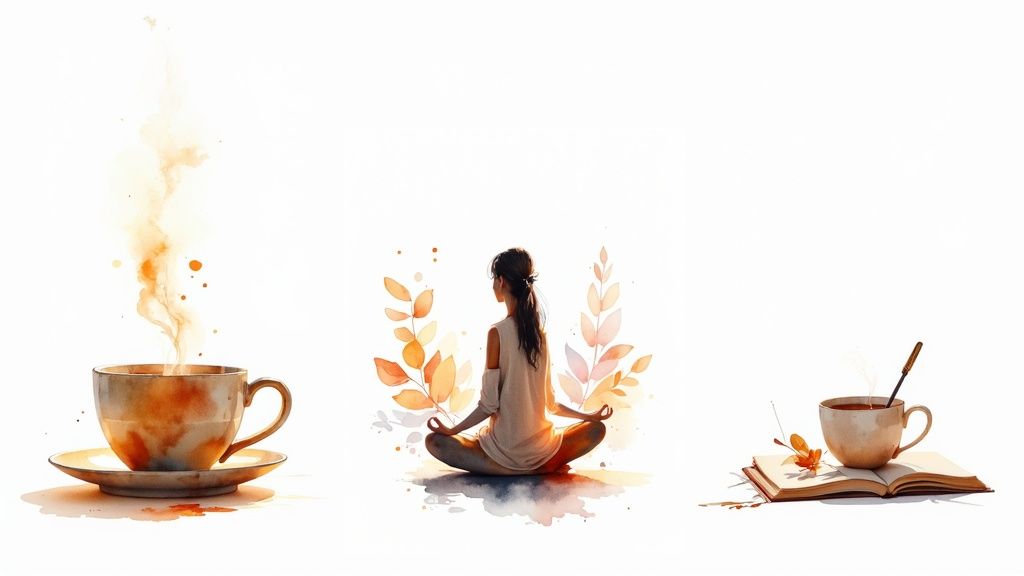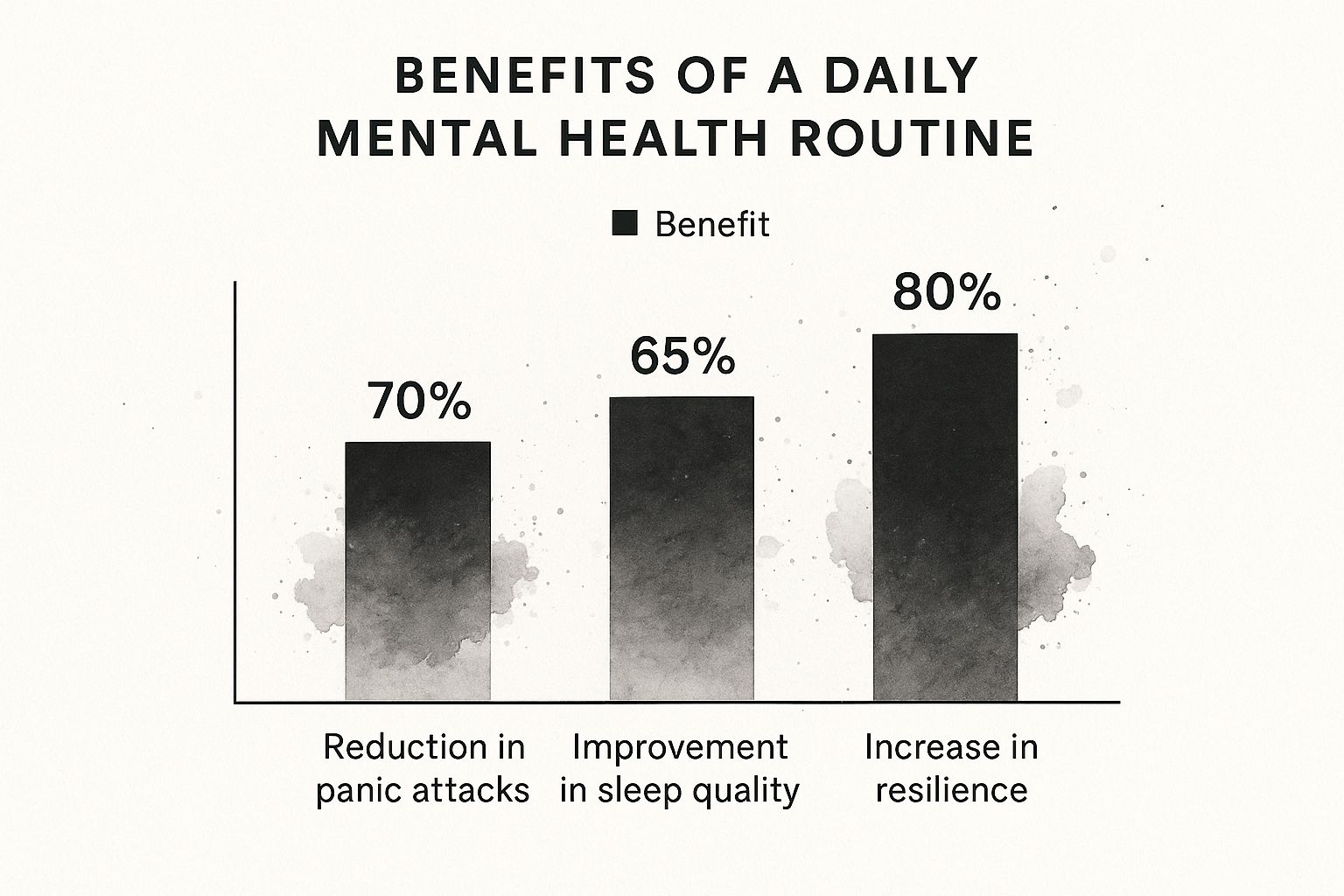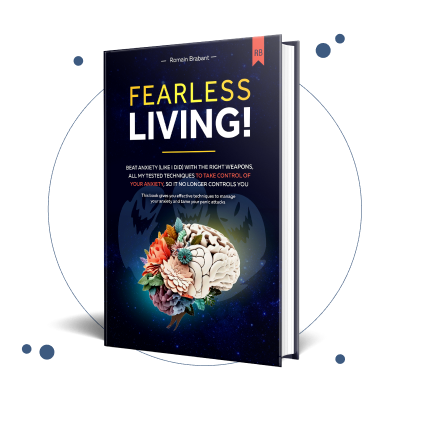
A solid daily routine for mental health is less about a rigid schedule and more about building a reliable framework that brings stability and predictability back into your life. It’s a practical, powerful way to quiet the noise of anxiety and carve out space for true healing, paving the way for a life free from panic.
The idea is simple: intentionally weave small, consistent actions throughout your day. From a mindful moment in the morning to a gentle wind-down at night, these habits work together to calm your nervous system and build resilience. This is how you begin to heal, one day at a time.
Why a Daily Routine Can Transform Your Mental Health
When you’re stuck in a cycle of anxiety or panic, life can feel utterly chaotic. Each day might feel like an uphill battle against your own mind, which is draining and can make you feel hopeless.
But what if you could build an anchor in that storm? What if you could find a path back to peace?
A simple, consistent daily routine for mental health does exactly that. It creates a predictable structure that sends a powerful signal to your nervous system: you are safe, and you are in control. This isn't about adding more pressure with an unforgiving schedule. It's about creating small pockets of stability that you can rely on, showing you that a panic-free life is not just a dream, but an achievable reality.
These consistent actions, repeated daily, build a quiet sense of accomplishment and self-trust. They show you, through your own efforts, that healing isn’t just some far-off possibility—it’s something you can actively create for yourself, starting right now.
Finding Hope in Structure
Living with anxiety often means wrestling with constant uncertainty. A routine directly counters that by bringing predictability into the picture. This eases the mental burden of making endless decisions and frees up your energy to focus on healing.
The scale of this challenge is huge. Globally, over 1 billion people are living with mental health conditions like anxiety, but it's crucial to remember that millions find their way to recovery. Structured, accessible support is a key part of that journey.
The infographic below shows just how powerful a consistent routine can be, highlighting real improvements in panic frequency, sleep quality, and overall resilience.

The data is clear: small, daily actions compound into major, life-altering changes. It’s a powerful reminder that you absolutely can regain a sense of control and live a life unburdened by constant anxiety.
To get a better sense of how these routines work, I've broken them down into three core pillars. Each part of the day has a specific focus designed to support your mental well-being from sunrise to sunset.
| Time of Day | Core Focus | Primary Benefit |
|---|---|---|
| Morning | Intention & Grounding | Sets a calm, hopeful tone for the day, reducing reactive stress. |
| Midday | Reset & Reconnect | Prevents overwhelm by creating a deliberate pause to reclaim your peace. |
| Evening | Wind-Down & Reflect | Promotes restful sleep, a cornerstone of healing and anxiety recovery. |
Thinking about your day in these three stages makes building a routine feel much more manageable. You're not trying to overhaul everything at once, but rather to introduce small, supportive habits at key moments that lead you toward lasting wellness.
Taking the First Step Toward Healing
The journey to living panic-free starts with one intentional choice at a time. By focusing on just a few core habits, you begin retraining your brain for calmness instead of crisis. These habits don’t need to be huge to make a profound difference.
The goal is progress, not perfection. A routine provides a gentle framework to return to on difficult days, reminding you that one setback doesn't erase your efforts. It’s your personalized roadmap back to a life of peace and freedom.
To truly transform your mental health, adopting a well-rounded self-care approach is key. You can get started with this ultimate daily self-care checklist with 7 core habits. Understanding the bigger picture of anxiety can also be incredibly empowering; you can learn more about key anxiety statistics in our detailed guide.
Crafting a Calm Morning to Start Your Day
How you start your morning can set the emotional tone for your entire day. If you live with anxiety, you know this all too well. Waking up can feel less like a gentle start and more like being launched straight into high alert. The goal here is to create a buffer—a quiet, sacred space between the stillness of sleep and the flood of daily demands.
This gives your nervous system a real chance to find its footing and begin the day from a place of calm.

This isn't about adding a complicated, hour-long ritual to your to-do list. Not at all. It's about reclaiming the first few moments of your day with small, deliberate acts of peace. That simple shift can be the first step toward proving to yourself that a peaceful, anxiety-free life isn't just possible—it's yours for the taking.
The First 30 Minutes: Your Screen-Free Sanctuary
One of the most powerful changes you can make to your daily routine for mental health is putting off checking your phone. The second you unlock that screen, you’re inviting a tidal wave of external stressors right into your bedroom—news alerts, work emails, social media drama. It's an instant jolt to your nervous system.
Resisting that urge creates a protective bubble. For the first 30 minutes after you wake up, make a pact with yourself to keep your phone on airplane mode or just leave it across the room. This simple boundary stops you from starting your day in reaction mode. It lets you check in with yourself before you check in with the world.
I worked with a client who used to wake up and immediately scroll through stressful news headlines, a habit that consistently triggered morning panic attacks. We swapped that single habit with listening to a calming podcast while she made her coffee. The change was profound—her morning anxiety dropped dramatically in just one week, giving her hope that she could, in fact, heal.
Grounding Yourself with Simple Practices
Once you've carved out that screen-free time, you can introduce a simple grounding practice. Again, this doesn't need to be complex. The idea is just to connect with your body and the present moment, anchoring yourself before the day's demands begin.
Here are a few gentle options to try:
- Five-Minute Guided Meditation: Using an app or a recording can be a game-changer for guiding you out of anxious thought loops. It teaches you to observe your thoughts without getting tangled up in them, a key skill for healing. Understanding the connection between meditation and anxiety can give you even more tools for this.
- Mindful Brewing: As your coffee or tea brews, put all your focus on the sensory experience. Notice the smell, the sound of the water, the warmth of the mug in your hands. This small act of mindfulness gently pulls your attention away from worry and into the present.
- Simple Stretches: Gently stretch your body for just a few minutes. Pay attention to how each movement feels, consciously releasing the physical tension that anxiety creates.
A calm morning routine is your first act of self-advocacy each day. It sends a clear message to your mind and body: "My peace comes first." This consistent practice builds a foundation of stability that you can return to, no matter what the day brings.
By intentionally crafting a quiet start, you aren't just managing anxiety—you're actively building a new baseline of peace. It's a powerful and hopeful step on the journey toward a life where you feel in control, grounded, and genuinely well.
Using a Midday Reset to Manage Stress
The middle of the day can feel like a pressure cooker. Work deadlines, family responsibilities, and the sheer weight of your own thoughts often collide right around lunchtime, pushing stress levels into overdrive.
This is where a midday reset comes in. It’s not a luxury—it’s an essential part of a solid daily routine for mental health, and a critical tool for preventing emotional burnout and reclaiming your sense of calm.
Think of it as a deliberate pause, a moment of compassionate self-care designed to interrupt the stress cycle before it spirals.

This proactive approach gives you the power to manage your energy and emotional state, so you don't just survive the afternoon but move through it with a sense of peace and control. It’s a powerful message to your anxious mind: "I have the tools to handle this, and I am healing."
Taking a Structured Break
Even on the most chaotic days, you can find a few minutes for a structured break. This isn't about aimlessly scrolling through your phone, which can often just ramp up anxiety. It’s about intentionally stepping away to reset your nervous system.
A few practical ideas:
- Mindful Walking: Spend just 10 minutes walking outside. Focus on the feeling of your feet on the ground, the air on your skin, and the sounds around you. This simple act can pull you right back into the present moment and away from worry.
- Desk-Based Breathing: Can't get away? Practice mindful breathing right where you are. Even a few deep, slow breaths signal to your body that it’s safe to relax. For more guidance, check out these powerful breathing exercises for anxiety.
- A Change of Scenery: Sometimes, all it takes is moving to a different room or looking out a window for five minutes to break the mental loop of stress.
The key is to make it a non-negotiable part of your day. This small act of self-preservation reinforces the belief that you can manage stress, which is a massive step toward living panic-free.
And the impact of unchecked midday stress is huge. Globally, depression and anxiety lead to an estimated 12 billion lost working days each year. In the UK alone, poor mental health costs employers around £56 billion annually, a figure that’s jumped by 25% since 2019. This shows just how vital these daily resets are for all of us.
Handling Unexpected Triggers
A routine doesn't just manage daily stress; it also equips you to handle the curveballs. When a stressful email or a difficult conversation throws you off balance, cognitive reframing techniques become a lifeline. This means consciously challenging and changing the way you view a situation, giving you back your power.
For instance, if you get some critical feedback, your anxious mind might jump straight to, "I'm failing."
Cognitive reframing helps you shift that to a more balanced, hopeful perspective, like, "This feedback is an opportunity to improve, not a judgment of my worth."
A powerful strategy I've seen work wonders is scheduling 'worry time.' One remote worker I know sets aside 15 minutes right after lunch to actively think about her anxieties. By containing those thoughts in a specific window, she stops them from hijacking her entire afternoon. It frees up an incredible amount of mental space.
This proactive management of your thoughts and energy is what makes a daily routine so effective. It’s not just about what you do, but how you think.
By building these small, intentional resets into your day, you prove to yourself, time and again, that you are capable of navigating life's stressors without being consumed by them. This is the foundation of lasting hope and a panic-free life.
Creating an Evening Sanctuary for Peace and Rest
A good night's sleep is one of the most powerful tools we have for healing from anxiety, yet it’s often the first casualty of a racing mind. Your evening routine is your chance to gently guide your brain away from the day's chaos and toward a state of deep calm. This isn't just about "going to bed"; it's about creating a true sanctuary that promotes genuine peace and restoration.
This transition from a state of 'doing' to simply 'being' is where so much of the healing happens. It's in these quiet moments that you give your mind the space it needs to find restorative calm, which is a huge step toward a panic-free life.

The good news? Building this sanctuary doesn't require a massive overhaul of your life. It’s all about small, consistent rituals that signal to your body and mind that the day is done and it's safe to let go and heal.
The Two-Hour Wind-Down Plan
To give your nervous system a real chance to calm down, start your wind-down routine about two hours before you plan to actually sleep. This creates a buffer zone, letting your mind shift gears from "on" to "off."
The most critical part of this plan happens in the final 60-90 minutes of your day: put away the screens. Your phone, tablet, and laptop need to go. We all know the blue light messes with melatonin production, but the real culprit is the content. Stressful news, endless social media scrolling, and work emails all keep your brain on high alert.
So, what do you do instead? Fill this time with something that disconnects you from the digital grind and connects you back to yourself.
- Read fiction. Getting lost in a good story is a fantastic way to escape your own anxious thoughts. Unlike non-fiction or work-related reading, it uses a different part of your brain and genuinely promotes relaxation.
- Listen to calming music or a podcast. Pick something that’s soothing and doesn't demand intense focus.
- Pick up a quiet hobby. Things like drawing, knitting, or even a simple puzzle can feel incredibly meditative.
This isn't just about avoiding screens; it's an act of deep self-care. You're telling your anxiety that, for this part of the day, peace is the only priority.
Offloading Worries with a Brain Dump
One of the biggest reasons we can't sleep is a mind that just won't switch off. A "brain dump" is a simple, practical way to tackle this head-on. About an hour before bed, grab a notebook and just write down everything that’s bouncing around in your head.
This isn't about structured, beautiful journaling. It's about offloading. Get all the worries, the to-do lists for tomorrow, and the unresolved frustrations out of your head and onto the paper. When you externalize them, they lose their power and are less likely to pop up the second your head hits the pillow.
You can also use this time to shift your focus to the positive. Keeping a gratitude journal is a brilliant way to retrain your brain to look for the good instead of defaulting to anxiety. You can learn more about how a gratitude journal for anxiety can make a real difference on your healing journey.
Finally, cap off your routine with a simple ritual that acts as the final "time for sleep" signal. My go-to is brewing a specific caffeine-free herbal tea, like chamomile or lavender, every single night. The repeated sensory experience—the smell, the warmth, the taste—creates a powerful association in your brain. It's a small, consistent act that builds a solid foundation for a peaceful night, which is absolutely essential for your long-term mental health and recovery.
How to Stay Consistent and Overcome Setbacks
Building a new daily routine for mental health is a powerful act of hope. But let's be real: staying consistent is challenging, especially when anxiety decides to show up uninvited.
The path to a panic-free life isn't a straight line. It's full of twists, turns, and the occasional detour. Learning to navigate those setbacks with self-compassion, not criticism, is where you discover you're far more resilient than your anxiety gives you credit for.
Remember, the goal here is progress, not perfection. Some days, your routine will feel like a superpower. On others, just swinging your legs out of bed will be the big win for the day. Both are completely valid and vital parts of your healing journey.
Track Your Wins, Not Your Flaws
Think of habit-tracking less like a report card and more like a tool for self-awareness and hope. It’s not about hitting a perfect streak; it’s about noticing and celebrating the small wins that prove healing is happening.
Use a simple checklist or a journal to jot down what you did accomplish. Managed five minutes of quiet time this morning? That's a win. Took that midday walk you planned? Celebrate it.
This simple practice starts to shift your entire perspective. Instead of seeing one missed meditation as a failure, you start seeing the three days you did meditate as a success. This builds the momentum and self-trust you need as you learn the practical steps for anxiety recovery that create lasting change.
The most powerful message you can send yourself is this: "I showed up for myself today, even when it was hard." Each small action reinforces the belief that you are capable of guiding your own healing.
This approach is crucial, especially since the need for these skills often starts early. Research shows that roughly 50% of people worldwide will experience a mental health disorder in their lifetime, and for about 75% of them, it begins by age 24. These numbers, highlighted by Harvard Medical School, underscore just how vital it is to build these supportive, life-changing habits.
The "One Small Thing" Rule
So what happens on those really tough days? The days when anxiety is screaming, and your carefully planned routine feels like climbing a mountain.
Don't throw in the towel. Instead, use the "one small thing" rule.
Just commit to doing one single thing from your routine. That’s it.
- Maybe it’s just brewing your calming evening tea.
- Perhaps it’s doing two minutes of deep breathing at your desk.
- It could even be as simple as drinking a glass of water with intention.
This strategy is deceptively powerful. It keeps the thread of your routine from breaking and proves that even on your worst days, you can still take a gentle step toward your own well-being. It’s a quiet act of defiance against the hopelessness that anxiety tries to sell you, reminding you that a panic-free life is built one small, courageous choice at a time.
Your Questions About Mental Health Routines, Answered
Starting something new can feel like a huge ask, especially when you're already running on empty. It’s totally normal to have questions—and even a few doubts. This is all part of the process of taking back control and building a life where anxiety isn’t calling the shots.
Let's get into some of the most common concerns I hear. My goal here is to give you clear, supportive answers that help you move forward with a little more confidence and hope.
How Long Until I See a Real Difference?
This is usually the first question on everyone's mind, and for good reason. You want to know that your efforts will lead to real change. While there's no magic timeline, most people start to feel a subtle shift—a little less edge, a bit more space to breathe—within just one to two weeks of consistent practice.
The initial goal isn’t to erase anxiety overnight. It’s about creating small, reliable moments of stability that your nervous system can begin to count on as proof that you are becoming safer and stronger.
Significant, lasting improvements? Those typically build over several months as you create a new foundation of well-being. Just remember, the key is consistency over intensity. Focusing on doing even a tiny part of your routine each day is what truly rebuilds that deep-seated feeling of safety and hope for a panic-free future.
What if I Miss a Day or Have a Setback?
Let’s be clear: missing a day is not a failure. It's an expected, completely normal part of being human and a part of the healing process. The most important thing is how you respond to it—with self-compassion, not criticism.
Please, avoid the all-or-nothing trap. You know the one, where a single slip-up makes you feel like you’ve wrecked all your progress and might as well give up. That's just the anxiety talking. You haven't lost anything. Just aim to restart with one small, gentle action the very next day.
Your healing journey is about persistence, not perfection. True resilience isn't learned by never stumbling; it's forged by getting back up again with kindness. Every time you choose to restart, you reinforce your commitment to a panic-free life.
How Can I Create a Routine with an Unpredictable Schedule?
If a rigid schedule feels laughably impossible for your life, shift your focus from strict times to "habit anchors." An anchor is something you already do consistently without even thinking about it. Things like turning on the coffee maker, finishing lunch, or changing out of your work clothes at the end of the day.
You then simply attach your new mental health practices to these existing anchors. It makes building new habits feel effortless.
- For example: "After I turn on the coffee maker, I will meditate for five minutes."
- Or maybe: "As soon as I get home from work, I will change clothes and go for a ten-minute walk."
This approach makes your daily routine for mental health incredibly flexible. It adapts to the reality of your life, rather than forcing your life to fit into a rigid, unforgiving box. It's a practical, hopeful way to make sure you can care for yourself, no matter what the day throws at you.
Ready to build your own personalized toolkit for a calmer, more controlled life? The Anxiety Checklist provides a step-by-step framework to help you create lasting change and heal. Learn more about The Anxiety Checklist.

